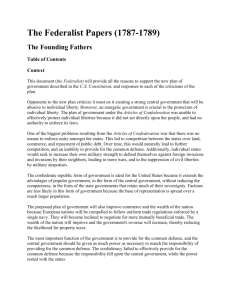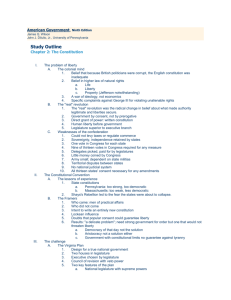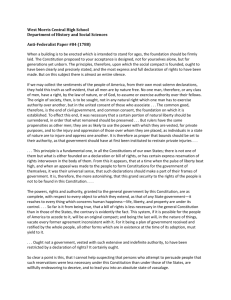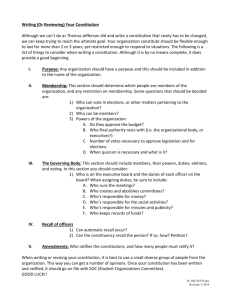ch2_wilson_notes
advertisement
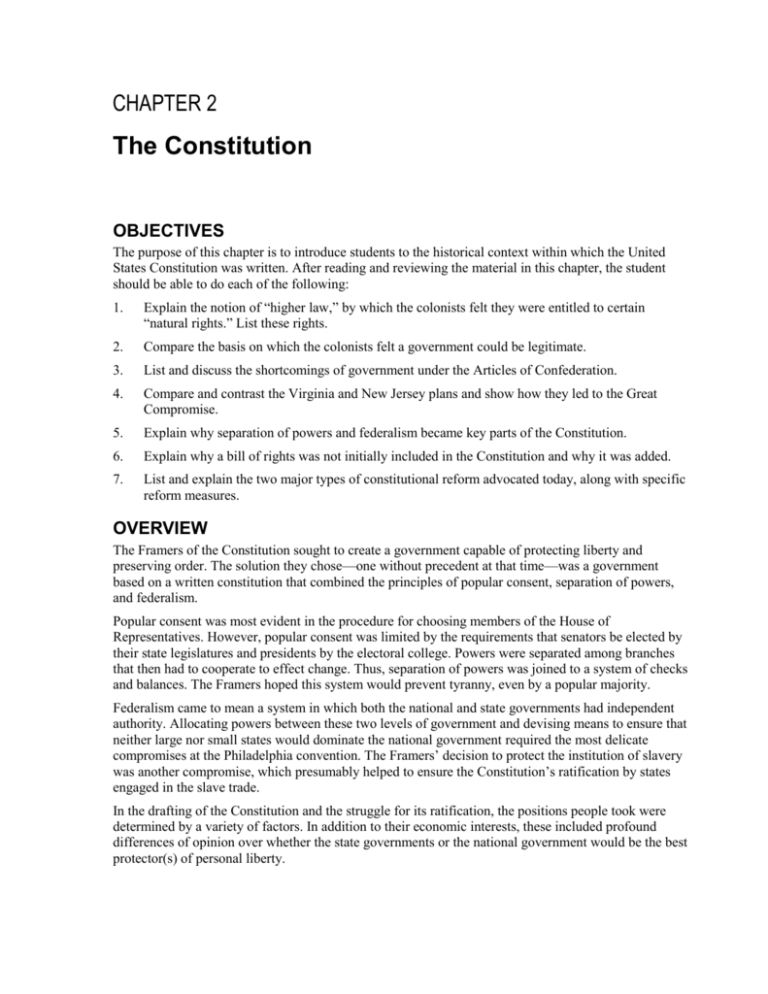
CHAPTER 2 The Constitution OBJECTIVES The purpose of this chapter is to introduce students to the historical context within which the United States Constitution was written. After reading and reviewing the material in this chapter, the student should be able to do each of the following: 1. Explain the notion of “higher law,” by which the colonists felt they were entitled to certain “natural rights.” List these rights. 2. Compare the basis on which the colonists felt a government could be legitimate. 3. List and discuss the shortcomings of government under the Articles of Confederation. 4. Compare and contrast the Virginia and New Jersey plans and show how they led to the Great Compromise. 5. Explain why separation of powers and federalism became key parts of the Constitution. 6. Explain why a bill of rights was not initially included in the Constitution and why it was added. 7. List and explain the two major types of constitutional reform advocated today, along with specific reform measures. OVERVIEW The Framers of the Constitution sought to create a government capable of protecting liberty and preserving order. The solution they chose—one without precedent at that time—was a government based on a written constitution that combined the principles of popular consent, separation of powers, and federalism. Popular consent was most evident in the procedure for choosing members of the House of Representatives. However, popular consent was limited by the requirements that senators be elected by their state legislatures and presidents by the electoral college. Powers were separated among branches that then had to cooperate to effect change. Thus, separation of powers was joined to a system of checks and balances. The Framers hoped this system would prevent tyranny, even by a popular majority. Federalism came to mean a system in which both the national and state governments had independent authority. Allocating powers between these two levels of government and devising means to ensure that neither large nor small states would dominate the national government required the most delicate compromises at the Philadelphia convention. The Framers’ decision to protect the institution of slavery was another compromise, which presumably helped to ensure the Constitution’s ratification by states engaged in the slave trade. In the drafting of the Constitution and the struggle for its ratification, the positions people took were determined by a variety of factors. In addition to their economic interests, these included profound differences of opinion over whether the state governments or the national government would be the best protector(s) of personal liberty. Chapter 2: The Constitution CHAPTER OUTLINE WITH KEYED-IN RESOURCES I. II. The problem of liberty (THEME A: THE POLITICAL PHILOSOPHY OF THE FOUNDERS) A. Colonists were focused on traditional liberties: 1. The right to bring legal cases before independent judges 2. The right to not have to quarter troops in their homes 3. The right to trade without burdensome restrictions 4. The rights to pay no taxes that they had not been established without direct representation 5. The colonists came to see independence as possible because they had lost confidence in the British constitution B. The colonial mind 1. Believed that men seek power because they are ambitious, greedy, and easily corrupted 2. Believed in a higher law embodying natural rights a) Life b) Liberty c) Property (Jefferson changed this to “pursuit of happiness”) 3. A war of ideology, not economics 4. Declaration of Independence cited specific complaints against George III for violating unalienable rights. C. The real revolution 1. The “real” revolution was the radical change in belief about what made authority legitimate and liberties secure. 2. Government exists by consent of the governed, not by royal prerogative. 3. Political power exercised by direct grant of power in a written constitution 4. Human liberty exists prior to government, and government must respect liberty. 5. Legislative branch created as superior to executive branch because the legislature directly represents the people. D. Weaknesses of the confederation (Articles of Confederation): 1. Could not levy taxes or regulate commerce 2. Sovereignty, independence retained by states 3. One vote in Congress for each state 4. Nine of thirteen votes in Congress required for any measure 5. Delegates to Congress chosen and paid by state legislatures 6. Little money coined by Congress 7. Army small and dependent on independent state militias 8. Territorial disputes between states led to open hostilities 9. No national judicial system 10. All thirteen states’ consent necessary for any amendments The Constitutional Convention (THEME B: THE CONSTITUTIONAL CONVENTION) A. The lessons of experience 1. State constitutions a) Pennsylvania: radically democratic, but trampled minority rights—government was too strong b) Massachusetts: less democratic: directly elected governor, but electors and officials had to own property; clear separation of powers 2. Shays’s Rebellion (Massachusetts) brought fear that states were about to collapse from internal dissension B. The Framers 1. Fifty-five (55) attending: men of practical affairs, including Continental army veterans and members of the Congress of the Confederation . Chapter 2: The Constitution 2. 3. Absent: Thomas Jefferson, John Adams, Samuel Adams, Patrick Henry An entirely new constitution was written, although the gathering was authorized only to revise Articles. 4. Primary concern was with defense of liberty as a natural right (based in Lockean reasoning). 5. Doubt that popular consent alone could guarantee liberty: fear of tyranny of the majority 6. “A delicate problem:” how could government be strong enough to preserve order but not threaten liberty III. The challenge A. The Virginia Plan 1. Strong national government organized into three branches 2. Bicameral legislature 3. Executive and members of the national judiciary to be chosen by legislature 4. Council of revision (executive and some judiciary branch members) with veto power; legislature could override the veto 5. Two key features of the plan: a) National legislature with supreme powers b) One legislative house, elected directly by the people B. The New Jersey Plan 1. Submitted as alternative to Virginia Plan 2. Generated from a fear that legislative representation would be based on population, allowing the more populous states always to outvote the less populous states 3. Sought to amend rather than replace the Articles of Confederation 4. Proposed one vote per state, so Congress would be the creature of the state governments 5. Protected small states’ interests while enhancing power of national government C. The Great Compromise (or Connecticut Compromise) 1. House of Representatives based on population and directly elected by people 2. Senate composed of two members per state and elected by state legislatures 3. Reconciled interests of large and small states—the former would dominate the House of Representatives, the latter would dominate the Senate IV. The Constitution and democracy A. Founders did not intend to create direct democracy 1. Physical impossibility in a vast country 2. Founders also mistrusted popular passions and were concerned to secure minority rights 3. Intended instead to create a republic, a government by representation B. Popular rule only one element of new government 1. State legislators to elect senators 2. Electors to choose president 3. Two kinds of majorities: voters (for example, the House of Representatives) and states (for example, the Senate) 4. Judicial review another limitation, though one not necessarily intended by Founders 5. Amendment process C. Key principles of representative government in the United States 1. Separation of powers: among branches of the national government 2. Federalism: power divided between national and state governments 3. Three categories of governmental powers a) Enumerated powers: given exclusively to the national government; include power to print money, declare war, make treaties, conduct foreign affairs Chapter 2: The Constitution b) V. Reserved powers: given exclusively to the states; include power to issue licenses and to regulate commerce wholly within a state c) Concurrent powers: shared by both national and state governments; include collecting taxes, building roads, borrowing money, establishing courts 4. Checks and balances allow national institutions to check each others’ powers (see How Things Work box) D. Government and human nature 1. Founders’ central belief: people would seek their own advantage, in and out of politics 2. Government based on popular consent was possible, but not inevitable. a) Aristotelian view (championed by Samuel Adams): government should improve human nature by cultivating virtue. b) Madisonian view: cultivation of virtue would require a government too strong, too dangerous; self-interest should be freely pursued within limits. 3. Factionalism could be harnessed to provide a source of unity and guarantee liberty. a) Separation of powers enables each branch to check the others. b) Federalism enables one level of government to check another. The Constitution and liberty A. Whether proposed constitution respected personal liberties was a primary debate during ratification. 1. Required ratification by conventions in at least nine states—the most democratic feature of the Constitution 2. Ratification process was technically illegal—the Articles, which still governed, could be amended only with unanimous agreement of the thirteen states 3. Framers knew that unanimity was not possible—the North Carolina and Rhode Island conventions did initially reject the Constitution B. The Antifederalist view 1. Liberty could be secure only in small republics. a) Otherwise national government would be distant from people, becoming tyrannical b) Strong national government would use powers to annihilate state functions 2. Nation needed, at best, a loose confederation of states with most of the power wielded by the state legislatures 3. If there was a strong national government, there should be many more restrictions on it. 4. Madison’s response (Federalist No. 10 and No. 51): personal liberty safest in large (extended) republics a) Coalitions were then more likely to be moderate because there would be a greater diversity of interests to be accommodated b) Government should be somewhat distant from the people to be insulated from their passions. c) The Federalist counterargument to the objections of the Antifederalists included: a. A focus on representative over direct democracy b. The development of a large diverse republic rather than a small concentrated one, so that diverse economic and cultural interest would mitigate against the formation of homogeneous and potentially tyrannical majorities 5. Reasons for the absence of a bill of rights a) Several guarantees already in Constitution (1) Right of habeas corpus . Chapter 2: The Constitution (2) (3) (4) (5) (6) (7) No bill of attainder No ex post facto law Trial by jury in criminal cases Citizens of each state guaranteed the privileges and immunities of citizens of every other state No religious tests for federal office No state could pass a law impairing the obligation of contracts b) c) C. D. Most states had bills of rights Intent in writing the Constitution was to limit federal government to specific powers Need for a bill of rights 1. Ratification impossible without one 2. Promise by key leaders to obtain one 3. Bitter struggle for ratification, narrowly successful 4. Twelve amendments approved by Congress; 10 ratified by the states and went into effect in 1791 The Constitution and slavery 1. Slavery was addressed in three provisions of the Constitution. a) House of Representatives apportionment—the “three-fifths compromise” b) Congress could not prohibit slave trade before 1808. c) Fugitive slave clause 2. Necessity of compromise: the Constitution would not have been ratified, and slavery would have continued under the Articles of Confederation with no prospective challenge possible. 3. Great (or Connecticut) Compromise favored smaller (mostly) northern states by giving equal representation to each state in the Senate, but it also favored southern, slaveholding states a. The three-fifths apportionment would have 33 rather than 47 House seats b. This led to the domination of the new government by southern-born presidents, House leadership, and the Supreme Court until the Civil War. 4. Legacy: civil war, social and political catastrophe VI. The motives of the Framers A. Economic interests at the convention 1. Economic interests of Framers varied widely. 2. Charles Beard: those who supported the Constitution expected to benefit economically from it. However, the economic interests of the Framers themselves did not dominate the convention. 3. No clear division along class lines found by historians in the 1950s 4. More recent research (1980s) suggests state economic considerations outweighed personal considerations. 5. Excluding the grave and enormous exception of slave holders, most delegates who voted to ratify the Constitution were not motivated by economic interest. B. Economic interests and ratification 1. Economic factors played larger role in state-ratifying conventions. 2. More likely to vote in favor of ratification: merchants, urban, owners of western lands, holders of government IOUs, non–slave owners 3. Less likely to vote in favor of ratification: farmers, nonholders of government IOUs, slave owners Chapter 2: The Constitution C. D. The Constitution and equality 1. Contemporary critics: government today is too weak a) Bows to special interests that foster economic inequality b) Changing views of liberty and equality are reflected in this criticism 2. Framers were more concerned with political inequality—they wanted to guard against political privilege. The Founding debate over church and state 1. Contrasting religious beliefs influenced the debate between Federalist and Antifederalist concerning the relationship of religion and government a) Antifederalists represented views similar to those of today’s religious conservatives. They attacked the Constitution’s ban on religious tests for holding public office and the First Amendment’s prohibition of the establishment of a national religion. b) Federalists took a different position, arguing that the Constitution should permit religious pluralism. They did not advocate a total separation between church and state, but they did favor a government that promoted a balance among different religions, with no one group using the power of government to persecute members of other religions. VII. Constitutional reform—modern views A. Reducing the separation of powers to enhance national leadership 1. Urgent problems cannot be solved—gridlock 2. Also, government agencies are exposed to undue interference from legislators and special interests 3. Proposed remedy: President should be more powerful and held accountable to voters 4. Proposed remedies to allow government to be more proactive and decisive: a) Allow Congress members to serve concurrently in Cabinet b) Allow president to dissolve Congress and call for a special election c) Empower Congress to call for a special presidential election before the end of a president’s term when the president has lost the nation’s confidence d) Require presidential and congressional candidates to run as a team in each congressional district e) Establish a single six-year term for president f) Lengthen terms in House to four years, so elections would be concurrent with the presidential election 5. Results uncertain, worse from these reforms? B. Making the system less democratic 1. Government does too much, not too little 2. Attention being given to special interest claims rather than long-term values 3. Proposals to cut back on government activism a) Limit amount of taxes collected b) Require a balanced budget c) President gained enhanced rescission authority (a delimited line-item veto) in 1996; this was overturned in 1998 d) Adopt a new line-item proposal that would address constitutional concerns by requiring Congress to approve presidential cuts with a “fast-track” majority vote e) Limit the authority of federal courts 4. Changes unworkable or open to evasion? C. Who is right? 1. Constitution not based on abstract reasoning or unproven factual arguments . Chapter 2: The Constitution 2. Crucial questions to ask when considering Constitutional reform a) How well has it worked in history? b) How well has it worked compared with the constitutions of other democratic nations? WEB RESOURCES Claremont Institute, A User’s Guide to the Declaration of Independence: http://www.founding.com Library of Congress, American Memory, Primary Documents in American History: http://memory.loc.gov/ammem/help/constRedir.html National Archives Experience, Charters of Freedom: http://www.archives.gov/national-archivesexperience/charters/charters.html National Constitution Center: http://www.constitutioncenter.org/explore/Welcome/index.shtml U.S. House of Representatives, Educational Resources: http://www.house.gov/house/Educate.shtml IMPORTANT TERMS amendment A new provision in the Constitution that has been ratified by the states. Antifederalists Those who favored a weaker national government. Articles of Confederation A weak constitution that governed America during and immediately after the Revolutionary War. bill of attainder A law that declares a person, without trial, to be guilty of a crime. Bill of Rights The first ten amendments to the U.S. Constitution. Chapter 2: The Constitution checks and balances The power of the legislative, executive, and judicial branches of government to block some acts by the other two branches. (See also separation of powers.) coalition An alliance of factions. concurrent powers Powers shared by the national and state governments. Constitutional Convention Meeting in Philadelphia in 1787 that produced a new constitution. enumerated powers Powers given to the national government alone. ex post facto law A law that makes an act criminal although the act was legal when it was committed. faction A group with a distinct political interest. federalism Government authority shared by national and state governments. Federalists Those who favor a stronger national government. Great (or Connecticut) Compromise Plan to have popularly elected House based on state population and a state-selected Senate, with two members for each state. habeas corpus An order to produce an arrested person before a judge. judicial review The power of the courts to declare laws unconstitutional. inalienable A human right derived from nature or God. line-item veto An executive’s ability to block a particular provision in a bill passed by the legislature. New Jersey Plan Proposal to create a weak national government. republic A government in which elected representatives make the decisions. reserved powers Powers given to the state governments alone. separation of powers Sharing of constitutional authority among three different branches of government. Shays’s Rebellion A 1787 rebellion in which ex–Revolutionary War soldiers attempted to prevent foreclosures of farms as a result of high interest rates and taxes. unalienable A human right derived from nature or God. Virginia Plan Proposal to create a strong national government. . Chapter 2: The Constitution THEME A: THE POLITICAL PHILOSOPHY OF THE FOUNDERS Instructor Resources Sebastian de Grazia. A Country with No Name: Tales From the Constitution. New York: Pantheon, 1997. Thomas Hobbes. Leviathan. Mineola, NY: Dover Publications, 2006. John Locke. The Second Treatise of Government. New York: Cambridge University Press, 1988. Jon Meacham. American Gospel: God, the Founding Fathers, and the Making of a Nation. New York: Random House, 2006. Charles de Secondat, Baron de Montesquieu. The Spirit of the Laws. New York: Cambridge University Press, 1989. Jennifer Nedelsky. Private Property and the Limits of American Constitutionalism. Chicago: University of Chicago Press, 1994. Ronald J. Pestritto and Thomas G. West, eds. The American Founding and the Social Compact. Lanham, MD: Lexington Books, 2003. Gary Rosen. American Compact: James Madison and the Problem of the Founding. Lawrence: University Press of Kansas, 1999. Jean-Jacques Rousseau. The Social Contract and the Discourses. London: Dent/Everyman’s Library, 1973. Gordon S. Wood. The Radicalism of the American Revolution. New York: Vintage Books, 1993. Summary The goal of the American Revolution was liberty. The colonists sought to protect the traditional liberties due British subjects—liberties embodied in the (unwritten) British constitution. Initially colonists believed these liberties were best protected if they (the colonists) remained part of the British empire, but opinion slowly shifted to favor independence. John Adams estimated that one-third of Americans supported the Revolution, one-third remained loyalists, and one-third were indifferent. The liberties the colonists fought to protect were based on natural rights ordained by God and discoverable in nature and history. These rights included life, liberty, and property. The Founders were heavily influenced by the British philosopher John Locke and his theory of a state of nature. In a state of nature, without government, people cherish life, liberty, and property, but these things are not secure because the strong can deprive the weak of their rights. Government is instituted to prevent this exploitation but must be based on the consent of the governed. Limited government is therefore required, because people will not consent to be ruled by a government that threatens their liberty. The Founders’ pessimistic view of human nature also influenced them in favor of limited government. A natural human lust for domination meant that a too-powerful government could easily become an engine of exploitation. The Founders clearly distrusted aristocracy, the rule of the few. But they also distrusted democracy, the rule of the many, which for many of the Founders meant mob rule. They feared that a democracy would be excessively subject to temporary popular passions and that minority rights would be insecure. The highly democratic Pennsylvania constitution, adopted in 1776, demonstrated this danger. Chapter 2: The Constitution Yet the ineffectiveness of the national government under the Articles of Confederation and the inability of government to deal with Shays’s Rebellion convinced many of the need for a stronger central government. Thus arose a difficult problem: how to devise a government strong enough to keep order yet not so strong as to threaten liberty. Faced with conflicting claims of aristocracy and democracy, the Founders devised a republic, a government with a system of representation. The direct election of the House of Representatives by the people was an important democratic provision. On the other hand, the election of senators by state legislatures, the practice of judicial review, and the difficulty of amending the Constitution were substantial limitations on popular rule. The separation of powers and federalism are the key means by which the Founders protected liberty. In a system in which political power is divided among three separate branches of government, usurpation by one branch will be fought by officials of the other two. It is not necessary that these officials be public spirited; their own ambition and desire for power will lead them to maintain the balance. Federalism likewise provides for state and federal governments to check each other. It should be noted that these principles reflect the Founders’ distrust of the people’s ability to govern themselves. Separation of powers and checks and balances, in combination, ensure that the national government controls itself. If this check fails, federalism enables the states to protect the people from abuse by the central government. The people were given little opportunity to influence public policy. The only “voice of the people” was in the election of members to the House of Representatives; the people were denied selection of any other national officials. Moreover, any action taken by the House could be blocked by the Senate. The Constitution clearly watered down the concept of democracy after the experience under the Articles of Confederation. The stress the Founders placed on liberty was consistent with equality as they understood it. They favored political equality, or equal rights before the law: government should not create unnatural and undesirable inequalities. To many people today, the proper role of government is to promote a greater degree of equality than would result if society were left alone. Discussion Questions 1. Why, if one is concerned with protecting human liberty, would one want to make the legislative branch of government dominant (rather than the executive or judicial)? Are there good reasons that someone concerned with liberty would distrust a strong executive? A powerful judiciary? Is liberty most often threatened by powerful political elites who escape public control or a majority intent on imposing its will on a minority? Which of these cases would lead one to favor a strong legislative branch? 2. Which features of the Constitution make it difficult for government to do or achieve anything? Why were they included? Suppose you wanted to make government more capable of acting to solve the pressing problems of the country. The following changes are discussed in the textbook, and each has its supporters. Which would you favor? a. Allow individuals to be appointed to the president’s Cabinet while still serving in Congress. b. Allow the president to dissolve Congress and call for a special election. c. Allow Congress to call for a special presidential election. d. Require the presidential and congressional candidates to run as a team in each district, putting an end to split-ticket voting. e. Institute a single six-year term for the president. . Chapter 2: The Constitution f. Lengthen the terms for the House of Representatives to four years, so that members would run for reelection with the president. 3. In what way does the Constitution respond to the grievances against the British monarch identified in the Declaration of Independence? What additional responses are found in the Bill of Rights? Were any complaints against King George III not addressed within the framework of the new government? 4. The Founders separated the authority over matters of national security into separate branches of government. Congress, for example, is given the responsibilities of declaring war and of financing military endeavors. The president, however, is responsible for directing the affairs of the military as commander in chief. What are the benefits of having this authority split between the two branches of government? What are the drawbacks of such an arrangement? Data and Perspectives for Analysis Designing a Political System Suppose you had a chance to design a government. What sort would you design? First, you would need to decide what you value in a political system. Look at the following pairs of statements and circle (a) or (b) in each case to indicate which attribute you would value more highly in your political institutions. In each instance, (a) is the Antifederalist position and (b) is the Federalist position. Which would you rather have? 1. (a) A political system with the greatest possible political democracy—that is, one that translates popular demands into laws and policies as effectively as possible Or (b) A political system that gives elected officials considerable latitude to do what they want to or feel is best without having to worry too much about public opinion 2. (a) A political system that can make major policy changes quickly Or (b) A political system in which major changes in policy are very hard to effect and happen only rarely 3. (a) A political system that allows minority groups to block governmental actions that they feel are unfair or unjust to them Or (b) A political system in which the majority always prevails, even in the face of minority opposition 4. (a) A political system that seeks to make its citizens virtuous and good Or (b) A political system that leaves its citizens alone to live as they wish 5. (a) A political system with power decentralized to represent the needs and wants of various localities Or (b) A political system with power centralized in one place, to allow coherent and consistent policy across an entire nation Chapter 2: The Constitution 6. (a) A political system that seeks to make its citizens unselfish and concerned with the common good Or (b) A political system that assumes that people are generally self-seeking and attempts to make the best of that fact Discussion Questions 1. Are your preferences closer to those of the Federalists or the Antifederalists? If you were a Federalist, would you have argued against the Bill of Rights? If you were an Antifederalist, would you have argued against ratifying the Constitution? 2. How do your answers reflect the political concerns of Americans today? If a constitutional convention were called to amend the document, what changes would likely be adopted? Why? THEME B: THE CONSTITUTIONAL CONVENTION Instructor Resources W.B. Allen and Gordon Lloyd, eds. The Essential Antifederalist. Lanham, MD: Rowman & Littlefield, 2002. Alexander Hamilton, John Jay, and James Madison. The Federalist Papers. Louis Hartz,. The Liberal Tradition in America. New York: Harcourt Brace, 1955. Ralph Ketcham, ed. The Anti-Federalist Papers and the Constitutional Convention Debates. New York: Signet Classics, 2003. Thurgood Marshall. “Race and the Constitution.” Social Policy (Summer 1987): 29–31. Mary E. Webster, ed. The Federalist Papers: In Modern Language Indexed for Today’s Political Issues. Bellevue, WA: Merril Press, 1999. Thomas G. West. Vindicating the Founders: Race, Sex, Class, and Justice in the Origins of America. Lanham, MD: Rowman & Littlefield Publishers, 1997. Summary The Constitutional Convention assembled in Philadelphia in 1787 with the delegates in general agreement that defects in the Articles of Confederation ought to be remedied. The delegates were first presented with the Virginia Plan, a comprehensive scheme for a wholly new national government with strongly centralized power. The New Jersey Plan, supported by opponents of strong national government, merely revised the existing Articles of Confederation. A committee was appointed to meet during the Fourth of July holidays to work out a compromise. The Great Compromise produced by this committee balanced the interests of the large and the small states by establishing a House of Representatives apportioned according to population and a Senate comprising two senators from each state. A host of other issues remained, but acceptable compromises were reached on all of them (including the slavery issue), and the new Constitution was approved. However, ratification of the Constitution could not take place until the Federalist view of a strong central government prevailed over Antifederalist assertions of state privileges and power. (The Antifederalists favored a small, loose confederation.) Madison, a staunch Federalist, effectively argued that liberty would best be preserved in a large republic that would allow greater diversity of thought. Still, the Federalists had to compromise on a bill of rights in order to attain ratification. . Chapter 2: The Constitution Ironically, Madison would later adopt a states’ rights position in composing the Virginia Resolutions, whereas his opponent at the ratifying convention in Virginia, Patrick Henry, would become a Federalist. Discussion Questions 1. How does the Constitution incorporate the Founders’ view of human nature? What features of the new government reflect the admonition of Federalist No. 51 that to prevent tyranny, the government must be able to control the governed, but also must be able to control itself? 2. Did the Constitutional Convention itself exemplify the principles that Madison set forth in Federalist No. 10? Were there factions? Could any faction dominate? Were justice and the general good reflected in the outcomes of the convention? 3. Explain what Jefferson meant when he asserted that “the tree of liberty must be refreshed from time to time with the blood of patriots and tyrants.” What is the meaning of this statement for the current generation of Americans?


